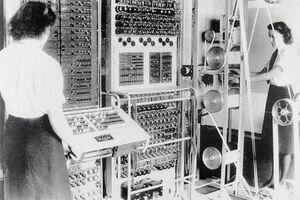Colossus computer (nonfiction): Difference between revisions
No edit summary |
No edit summary |
||
| (One intermediate revision by the same user not shown) | |||
| Line 1: | Line 1: | ||
[[File:Colossus_Mark_2.jpg|thumb|A Colossus Mark 2 computer being operated by Wrens Dorothy Du Boisson (left) and Elsie Booker. The slanted control panel on the left was used to set the "pin" (or "cam") patterns of the Lorenz. The "bedstead" paper tape transport is on the right.]]'''Colossus''' was a set of computers developed by British codebreakers in the years 1943–1945 to help in the cryptanalysis of the Lorenz cipher. Colossus used thermionic valves (vacuum tubes) to perform Boolean and counting operations. Colossus is thus regarded as the world's first programmable, electronic, digital computer, although it was programmed by switches and plugs and not by a stored program. | [[File:Colossus_Mark_2.jpg|thumb|A Colossus Mark 2 computer being operated by Wrens Dorothy Du Boisson (left) and Elsie Booker. The slanted control panel on the left was used to set the "pin" (or "cam") patterns of the Lorenz. The "bedstead" paper tape transport is on the right.]]'''Colossus''' was a set of computers developed by British codebreakers in the years 1943–1945 to help in the cryptanalysis of the Lorenz cipher. Colossus used thermionic valves (vacuum tubes) to perform Boolean and counting operations. Colossus is thus regarded as the world's first programmable, electronic, digital computer, although it was programmed by switches and plugs and not by a stored program. | ||
Colossus was designed by research telephone engineer [[Tommy Flowers (nonfiction)|Tommy Flowers]] to solve a problem posed by mathematician Max Newman at the Government Code and Cypher School (GC&CS) at Bletchley Park. [[Alan Turing (nonfiction)|Alan Turing]]'s use of probability in cryptanalysis contributed to its design. It has sometimes been erroneously stated that Turing designed Colossus to aid the cryptanalysis of the Enigma. Turing's machine that helped decode Enigma was the electromechanical [[Bombe (nonfiction)|Bombe]], not Colossus. | Colossus was designed by research telephone engineer [[Tommy Flowers (nonfiction)|Tommy Flowers]] to solve a problem posed by mathematician Max Newman at the Government Code and Cypher School (GC&CS) at [[Bletchley Park (nonfiction)|Bletchley Park]]. [[Alan Turing (nonfiction)|Alan Turing]]'s use of probability in cryptanalysis contributed to its design. It has sometimes been erroneously stated that Turing designed Colossus to aid the cryptanalysis of the Enigma. Turing's machine that helped decode Enigma was the electromechanical [[Bombe (nonfiction)|Bombe]], not Colossus. | ||
The prototype, Colossus Mark 1, was shown to be working in December 1943 and was operational at [[Bletchley Park (nonfiction)|Bletchley Park]] by January 1944 according to some sources and certainly by 5 February 1944. | The prototype, Colossus Mark 1, was shown to be working in December 1943 and was operational at [[Bletchley Park (nonfiction)|Bletchley Park]] by January 1944 according to some sources and certainly by 5 February 1944. | ||
| Line 23: | Line 23: | ||
* [[Bletchley Park (nonfiction)]] | * [[Bletchley Park (nonfiction)]] | ||
* [[Bombe (nonfiction)]] - different computer, designed by [[Alan Turing (nonfiction)|Alan Turing]] | * [[Bombe (nonfiction)]] - different computer, designed by [[Alan Turing (nonfiction)|Alan Turing]] | ||
* [[J. H. C. Whitehead (nonfiction)]] | |||
* [[Tommy Flowers (nonfiction)]] | * [[Tommy Flowers (nonfiction)]] | ||
| Line 29: | Line 30: | ||
* [https://en.wikipedia.org/wiki/Colossus_computer Colossus computer] @ Wikipedia | * [https://en.wikipedia.org/wiki/Colossus_computer Colossus computer] @ Wikipedia | ||
[[Category:Nonfiction (nonfiction)]] | [[Category:Nonfiction (nonfiction)]] | ||
Latest revision as of 12:59, 18 November 2017
Colossus was a set of computers developed by British codebreakers in the years 1943–1945 to help in the cryptanalysis of the Lorenz cipher. Colossus used thermionic valves (vacuum tubes) to perform Boolean and counting operations. Colossus is thus regarded as the world's first programmable, electronic, digital computer, although it was programmed by switches and plugs and not by a stored program.
Colossus was designed by research telephone engineer Tommy Flowers to solve a problem posed by mathematician Max Newman at the Government Code and Cypher School (GC&CS) at Bletchley Park. Alan Turing's use of probability in cryptanalysis contributed to its design. It has sometimes been erroneously stated that Turing designed Colossus to aid the cryptanalysis of the Enigma. Turing's machine that helped decode Enigma was the electromechanical Bombe, not Colossus.
The prototype, Colossus Mark 1, was shown to be working in December 1943 and was operational at Bletchley Park by January 1944 according to some sources and certainly by 5 February 1944.
An improved Colossus Mark 2 that used shift registers to quintuple the processing speed, first worked on 1 June 1944, just in time for the Normandy landings on D-Day. Ten Colossi were in use by the end of the war and an eleventh was being commissioned. Bletchley Park's use of these machines allowed the Allies to obtain a vast amount of high-level military intelligence from intercepted radiotelegraphy messages between the German High Command (OKW) and their army commands throughout occupied Europe.
The existence of the Colossus machines was kept secret until the mid-1970s; the machines and the plans for building them had previously been destroyed in the 1960s as part of the effort to maintain the secrecy of the project. This deprived most of those involved with Colossus of the credit for pioneering electronic digital computing during their lifetimes. A functioning rebuild of a Mark 2 Colossus was completed in 2008 by Tony Sale and some volunteers; it is on display at The National Museum of Computing at Bletchley Park.
In the News
Fiction cross-reference
Nonfiction cross-reference
- Alan Turing (nonfiction)
- Bletchley Park (nonfiction)
- Bombe (nonfiction) - different computer, designed by Alan Turing
- J. H. C. Whitehead (nonfiction)
- Tommy Flowers (nonfiction)
External links:
- Colossus computer @ Wikipedia
